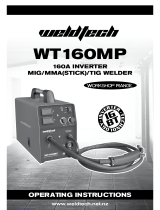
PROBLEM POSSIBLE CAUSE REMEDY (Numbers refer to chapter and item heading)
1. Power source stops Overheating protection activated due to overload Protection automatically resets when transformer has cooled (about 15 min).
2. No weld current Rectifier blown Replace rectifier.
3. No weld current
Bad connection between clamp & workpiece
Break in earth lead
Break in torch lead
Clean or grind contact surface and weld area.
Repair or replace earth lead.
Repair or replace torch lead.
4. Feed motor not working, lamp is on
Fuse blown
Gear damaged or worn
Motor defective
Replace fuse 1.5 amp.
Contact service agent.
Replace motor (Contact service agent).
5. Wire does not feed, feed roller rotates
Pressure roller improperly adjusted
Dirt, copper, dust, etc, have collected in torch liner
Gas cup (Nozzle) or tip defective. Faulty speed control
Deformed wire
Adjust tension.
Clean the liner from the machine forward. Use compressed air. If too much
dirt, replace the liner.
Replace gas cup (nozzle) and/or tip. (See section 6.3).
Check roller tension and adjust it if necessary (See section 6.4).
6. Wire feeds unevenly
Dirt, etc, in liner
Gas cup (Nozzle) or Tip defective
Gas cup (Nozzle) spattered
Feed roller groove clogged
Feed roller groove deformed
Pressure roller tension improper
Clean the liner from the machine forward. Use compressed air.
Replace gas cup (nozzle) and/or tip. (See fig.15).
Clean or replace gas cup (nozzle) (See fig.15).
Clean feed roller. (See section 10.3).
Replace feed roller. (See section 6.1.5).
Adjust tension. (See section 6.4).
7. Unstable arc
Incorrect settings
Impurities in weld area
Worn or defective gas cup (nozzle)
Check settings. (Refer to Welding Reference Table).
Clean and/or grind workpiece. (See section 8.2.1).
Replace gas cup (nozzle). (See fig.15).
8. Porous weld
No gas
Gas cup clogged
Draft blowing away shielding gas
Rusty or dirty joints
Torch too far from or at wrong angle to work
Gas leak
Dirty Workpiece
Open gas cylinder, regulate gas flow.
Clean or replace cup. (See fig.15).
Screen off welding site or increase gas flow.
Clean or grind the workpiece (See section 8.2.1).
The distance from gas cup to workpiece should be 8-10mm
Check contact tip and nozzle.
Check hoses, connections and torch assembly. (See section 5.5).
Press the gas cup into correct position.
9. Electrode sticking in gas cup (nozzle)
Worn or defective gas cup (nozzle)
Electrode deformed
Wire speed too slow
Replace gas cup (nozzle). (See fig.15).
Check roller tension. (See section 6.4 ).
Adjust wire feed rate control. (See section 6.6 ).
10. Irregular weld bead
Torch incorrectly held
Wire weaving in weld pool
Use correct torch angle.
Check roller tension and adjust as needed. (See section 6.4).
11. Weld bead too narrow and raised
Weld current too high
Weld speed too low
Increase power and wire speed.
Move torch slower and weave a little more.
12. Weld bead too wide
Weld current too high
Weld speed too low
Arc too long
Decrease power and wire speed.
Move torch faster and weave less.
Bring torch closer to workpiece.
13. Poor penetration
Weld current too high
Arc too long
Increase power and wire speed.
Bring torch closer to workpiece.
14. Excessive penetration
Weld current too high
weld speed too slow
incorrect distance of torch to workpiece
Decrease power and wire speed.
Move torch faster.
Torch distance should be 8-10mm.
15. Fuse blowing
Tension too great
Gas cup contact tip clogged
Release tension. (See section 6.2.1).
Clean gas cup and contact tip. (See fig.15).
16. Coils of wire on reel overlap, or wire is
oxidised. Coils break or fall under wheel.
Tension to loose or tight. Coil damaged or wire twisted. Reset tension. Change wire reel.
17. Wire runs through torch but there is no
welding current
Defective contactor.
Worn contacts of contactor regulator
Regulation switch problem
Faulty rectifier.
Fault on electronic circuit of contactor
Work cable not connected correctly.
Check coil ends, change coil if necessary.
Check, clean contacts, change if oxidation is present.
Check secondary voltage for each switch setting.
Disconnect rectifier from secondary, check each diode goes one way only.
If not change rectifier.
Change control module.
Connect work clamp directly to workpiece. Check wire is in good condition
and making good contact with clamp.
Sealey Group, Kempson Way, Suffolk Business Park, Bury St Edmunds, Suffolk. IP32 7AR
01284 757500 01284 703534 sales@sealey.co.uk www.sealey.co.uk
Note: It is our policy to continually improve products and as such we reserve the right to alter data, specifications and component parts without prior
notice.
Important: No Liability is accepted for incorrect use of this product.
Warranty: Guarantee is 12 months from purchase date, proof of which is required for any claim.
WEEE REGULATIONS
Dispose of this product at the end of its working life in compliance with the EU Directive on Waste Electrical and Electronic Equipment
(WEEE). When the product is no longer required, it must be disposed of in an environmentally protective way. Contact your local solid
waste authority for recycling information.
ENVIRONMENT PROTECTION
Recycle unwanted materials instead of disposing of them as waste. All tools, accessories and packaging should be sorted, taken to
a recycling centre and disposed of in a manner which is compatible with the environment. When the product becomes completely
unserviceable and requires disposal, drain any fluids (if applicable) into approved containers and dispose of the product and fluids
according to local regulations.
Original Language Version
© Jack Sealey Limited SUPERMIG255.V2 Issue:1 - 11/07/22










